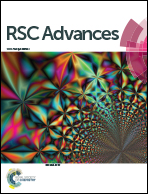Fluorescent paper sensor fabricated by carbazole-based probes for dual visual detection of Cu2+ and gaseous H2S†
Abstract
We report a fluorescent carbazole-based probe to achieve visual detection of Cu2+ and gaseous H2S with paper sensors in a fluorescent “on–off–on” mode. A common carbazole mother molecule is reconstructed by dual substitute and hydrazine reactions to obtain triple dentates to a single Cu2+ ion, and thus the fluorescence of the carbazole ring is strongly quenched by the captured Cu2+. Subsequently, the coordinative Cu2+ can be snatched by S2− via the formation of CuS, leading to the recovery of carbazole fluorescence. The above reactions provide the sensitive and prompt detection of Cu2+ and S2− with the limits of 65 nM and 0.29 μM, respectively. The reusability of the “on–off–on” fluorescent switch is well demonstrated by a recycling experiment with alternate additions of Cu2+ and S2−. Moreover, paper sensors are fabricated and used for the visual detection of Cu2+ and gaseous H2S with the limits of 10−6 M and 15 ppm.


 Please wait while we load your content...
Please wait while we load your content...